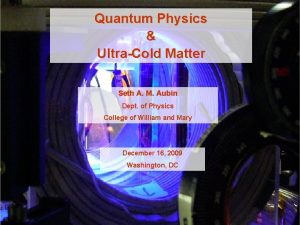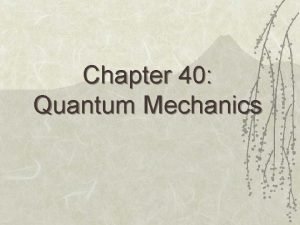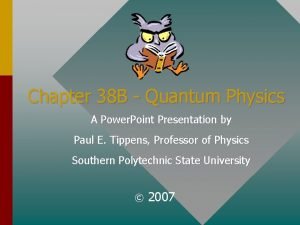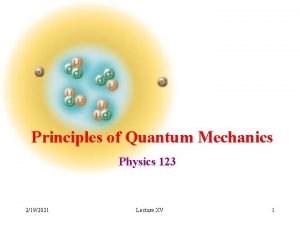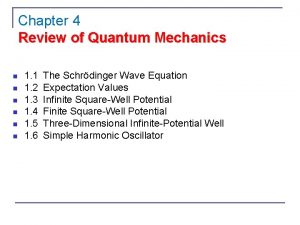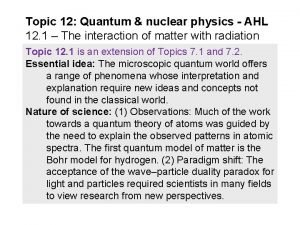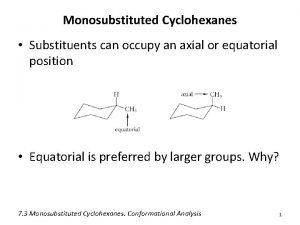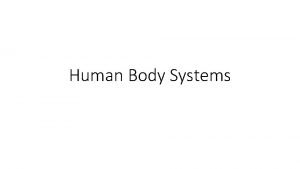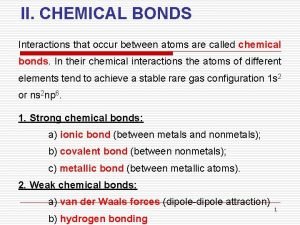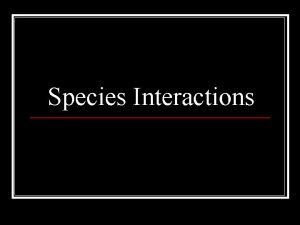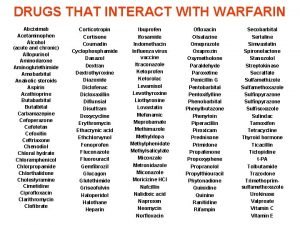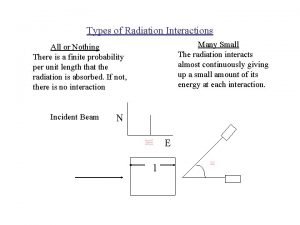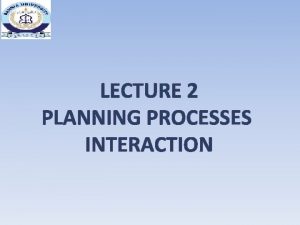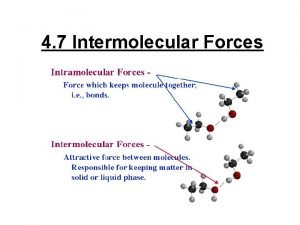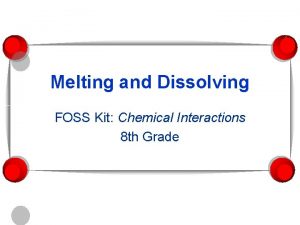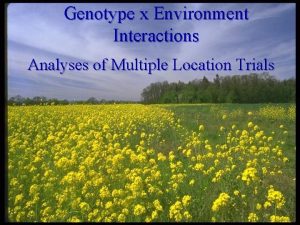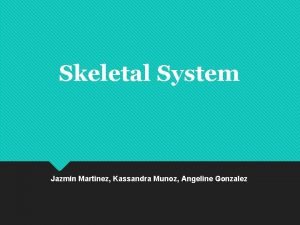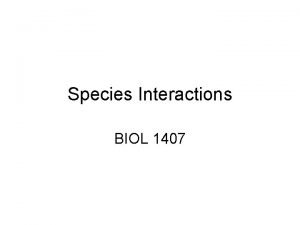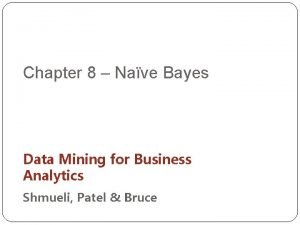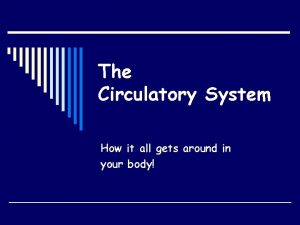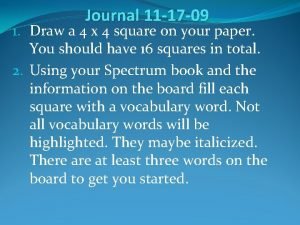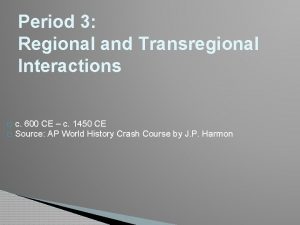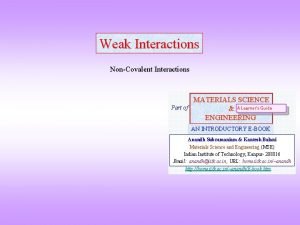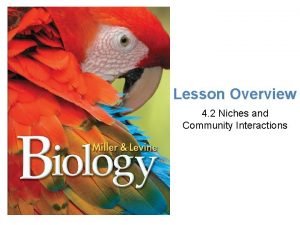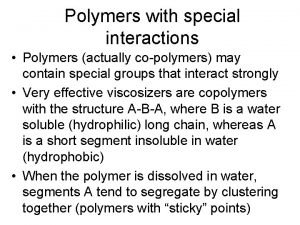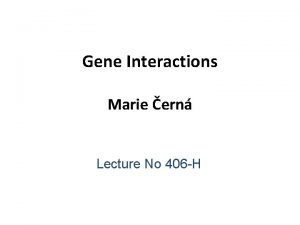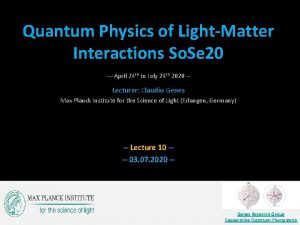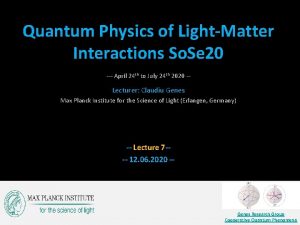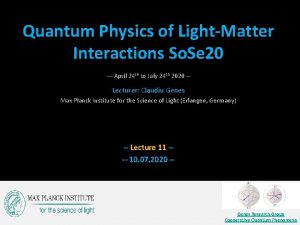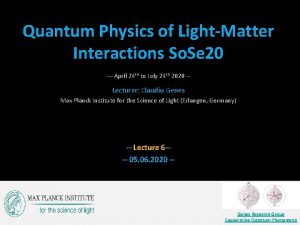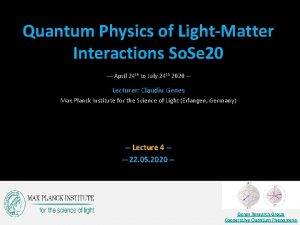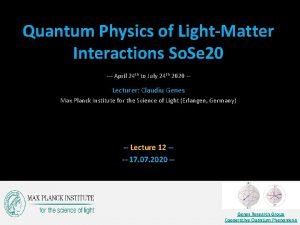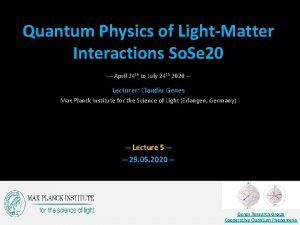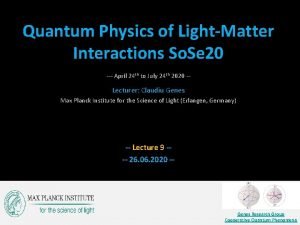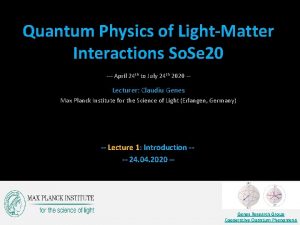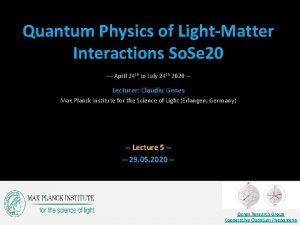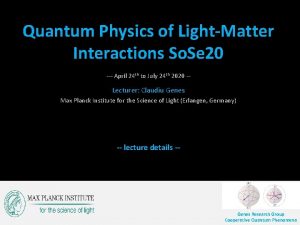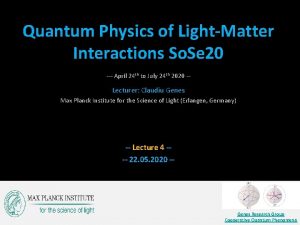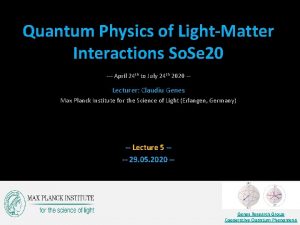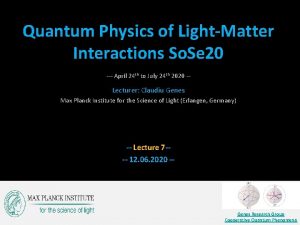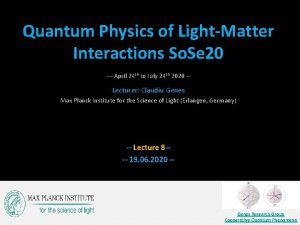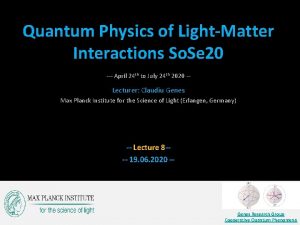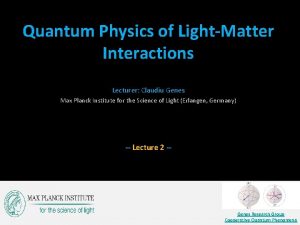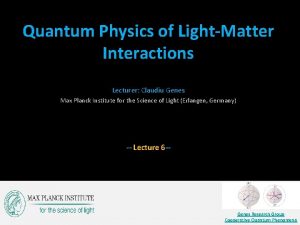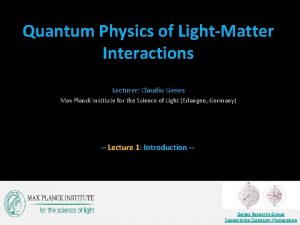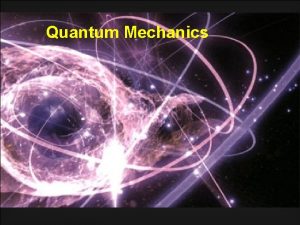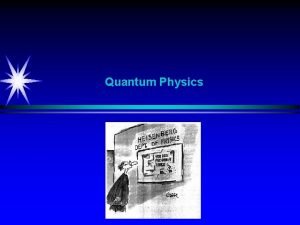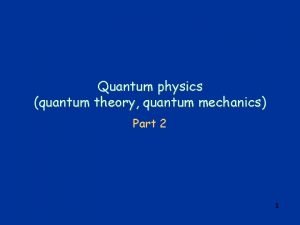Quantum Physics of LightMatter Interactions So Se 20






















































- Slides: 54

Quantum Physics of Light-Matter Interactions So. Se 20 --- April 24 th to July 24 th 2020 -- Lecturer: Claudiu Genes Max Planck Institute for the Science of Light (Erlangen, Germany) -- Lecture 3 --- 15. 05. 2020 -- Genes Research Group Cooperative Quantum Phenomena

From the last class… Modes of light inside the quantization box k-propagation direction 2 possible polarizations

From the last class… Modes of light inside the quantization box q Replace c-numbers with non-commuting bosonic operators q The electric field operator q Where the zero-point electric field amplitude is k-propagation direction 2 possible polarizations

From the last class… Light-matter interactions q The fully quantum light-matter Hamiltonian q The light-matter coupling strength per mode is

From the last class… Light-matter interactions q The fully quantum light-matter Hamiltonian q The light-matter coupling strength per mode is q The interaction part can be read in terms of creation of a photon accompanying the transition of an electron from excited to ground state and viceversa

Spontaneous emission of an initially excited TLS Initial excited state and no photon mode occupied q Only one possible process (destroy excitation in the TLS and excite a photon mode)

Spontaneous emission of an initially excited TLS Initial excited state and no photon mode occupied q Only one possible process (destroy excitation in the TLS and excite a photon mode) q Notice that there an infinite number of channels for decay each with a small probability related to the TLS-photon coupling

Spontaneous emission of an initially excited TLS Initial excited state and no photon mode occupied q Only one possible process (destroy excitation in the TLS and excite a photon mode) q Notice that there an infinite number of channels for decay each with a small probability related to the TLS-photon coupling q Dynamics is purely unitary in an infinitely dimensional Hilbert space with basis states ,

Open system dynamics - dissipation The need for a master equation q Dynamics in the quantization box is complicated to describe: owing to the infinite dimensional Hilbert space q One would desire to reduce the dynamics to the system of interest (the two level system – a two dimensional Hilbert space)

Open system dynamics - dissipation The need for a master equation q Dynamics in the quantization box is complicated to describe: owing to the infinite dimensional Hilbert space q One would desire to reduce the dynamics to the system of interest (the two level system – a two dimensional Hilbert space) q First step: dynamics can be followed at the level of the density operator (von. Neumann equation of motion)

Open system dynamics - dissipation The need for a master equation q Dynamics in the quantization box is complicated to describe: owing to the infinite dimensional Hilbert space q One would desire to reduce the dynamics to the system of interest (the two level system – a two dimensional Hilbert space) q First step: dynamics can be followed at the level of the density operator (von. Neumann equation of motion) q Some factorization assumption can be employed at some initial time t

Open system dynamics - dissipation The procedure… q Start with the full quantum light-matter Hamiltonian

Open system dynamics - dissipation The procedure… q Start with the full quantum light-matter Hamiltonian q Transformation to an interaction picture with unitary evolution q Resulting full Hamiltonian in the interaction picture

Open system dynamics - dissipation The procedure… q Start with the full quantum light-matter Hamiltonian q Transformation to an interaction picture with unitary evolution q Resulting full Hamiltonian in the interaction picture q Notice that the two operators above are only referring to the field states

Open system dynamics - dissipation The procedure… q Perform a formal integration (exact, there are no approximations) t t 1 Δt time

Open system dynamics - dissipation The procedure… q Perform a formal integration (exact, there are no approximations) q Another formal time integration (still exact) t t 2 t 1 Δt time

Open system dynamics - dissipation The procedure… q Perform a formal integration (exact, there are no approximations) q Another formal time integration (still exact) q …and another one… t t 3 t 2 t 1 Δt time

Open system dynamics - dissipation The procedure… q One can keep doing this for a sequence of ordered time t t 3 t 2 t 1 Δt time

Open system dynamics - dissipation The procedure… q One can keep doing this for a sequence of ordered time q However, we truncate assuming weak photon-electron interactions t t 3 t 2 t 1 Δt time

Open system dynamics - dissipation The procedure… q One can keep doing this for a sequence of ordered time q However, we truncate assuming weak photon-electron interactions q …and perform the trace over the field degree of freedom t t 3 t 2 t 1 Δt time

Open system dynamics - dissipation The unavoidable mathematical steps… q Tracing procedure q …where the compound index means

Open system dynamics - dissipation The unavoidable mathematical steps… q Tracing procedure q …where the compound index means q For example the trace over the density matrix of the vacuum leads to

Open system dynamics - dissipation The unavoidable mathematical steps… q Tracing procedure q …where the compound index means q For example the trace over the density matrix of the vacuum q The first order contribution leads to

Open system dynamics - dissipation The unavoidable mathematical steps… q Tracing procedure q …where the compound index means q For example the trace over the density matrix of the vacuum q The first order contribution leads to

Open system dynamics - dissipation The unavoidable mathematical steps… q Tracing procedure q …where the compound index means q For example the trace over the density matrix of the vacuum q The first order contribution q We conclude leads to

Open system dynamics - dissipation The unavoidable mathematical steps… q Second order traces (4 terms)

Open system dynamics - dissipation The unavoidable mathematical steps… q Second order traces (4 terms) q …following steps as described before (see Lecture notes for more details) one gets

Open system dynamics - dissipation The unavoidable mathematical steps… q Second order traces (4 terms) q …following steps as described before (see Lecture notes for more details) one gets Only matter part Only field part

Open system dynamics - dissipation Partial result q A difference equation for the matter part only Remember the starting point

Open system dynamics - dissipation Partial result q A difference equation for the matter part only q …where the coefficients stem from time integration and the correlations of the time dependent operators referring to the field Remember the starting point

Open system dynamics - dissipation Partial result q A difference equation for the matter part only q …where the coefficients stem from time integration and the correlations of the time dependent operators referring to the field q To ruin the surprise, of course we wish to get the terms above proportional to we can turn the equation above into a differential equation Remember the starting point in which case

Open system dynamics - dissipation …a few more tedious steps q Starting with

Open system dynamics - dissipation …a few more tedious steps q Starting with q We find that the trace has a simple form . . using

Open system dynamics - dissipation …a few more tedious steps q Starting with q We find that the trace has a simple form . . using q This brings us to the task ahead which is to estimate

Open system dynamics - dissipation Evaluating the coefficients q To evaluate q First the sum can be turned into an integral (with the density of optical states )

Open system dynamics - dissipation Evaluating the coefficients q To evaluate q First the sum can be turned into an integral (with the density of optical states q With a few more steps (see Lecture notes for details) we learn that )

Open system dynamics - dissipation Evaluating the coefficients q To evaluate q First the sum can be turned into an integral (with the density of optical states ) q With a few more steps (see Lecture notes for details) we learn that q The time integral is a bit complicated but detailed in the Lecture notes so I’ll state the result

Open system dynamics - dissipation The master equation for spontaneous emission q We turn the difference equation into a differential equation via

Open system dynamics - dissipation The master equation for spontaneous emission q We turn the difference equation into a differential equation via q Then we end up with the following equation

Open system dynamics - dissipation The master equation for spontaneous emission q We turn the difference equation into a differential equation via q Then we end up with the following equation

Open system dynamics - dissipation The master equation for spontaneous emission q We turn the difference equation into a differential equation via q Then we end up with the following equation Linblad form

Open system dynamics - dissipation Effect of the Linblad term on population and coherence q Let us explicitly write the effect of the Lindblad superoperator onto the evolution of the system’s density matrix. We do this in matrix form by the following identifications q …and for the matrices

Open system dynamics - dissipation Effect of the Linblad term on population and coherence q Let us explicitly write the effect of the Lindblad superoperator onto the evolution of the system’s density matrix. We do this in matrix form by the following identifications q …and for the matrices q One can then write the free evolution and Linblad terms in matrix form

Open system dynamics - dissipation Effect of the Linblad term on population and coherence q Let us explicitly write the effect of the Lindblad superoperator onto the evolution of the system’s density matrix. We do this in matrix form by the following identifications q …and for the matrices q One can then write the free evolution and Linblad terms in matrix form q Finally we derive

Open system dynamics - dissipation Effect of the Linblad term on population and coherence q Starting with this q Evolution of excited state population (decay at twice the decay rate) q Evolution of the coherence (half of the decay rate of the population and rotation at the TLS frequency splitting) q Ground state accumulation of population

Bloch equations Time dynamics of the driven-dissipative TLS q Let us now add a laser drive such that the Hamiltonian is

Bloch equations Time dynamics of the driven-dissipative TLS q Let us now add a laser drive such that the Hamiltonian is q The master equation is q Let’s sandwich it with bras and kets from the left and write and compute the evolution of the coherence

Bloch equations Time dynamics of the driven-dissipative TLS q Let us now add a laser drive such that the Hamiltonian is q The master equation is q Let’s sandwich it with bras and kets from the left and write and compute the evolution of the coherence q …and after a few simple calculations we get

Bloch equations Time dynamics of the driven-dissipative TLS q Let us remove the time dependence in the Bloch equations q. . by the following changes of variables

Bloch equations Time dynamics of the driven-dissipative TLS q Let us remove the time dependence in the Bloch equations q. . by the following changes of variables q We end up with time-independent coupled linear differential equations q where the detuning is defined as

…in the next class Time dynamics of the driven-dissipative TLS q Distinction between transient versus steady state regime q Steady state response of a TLS to classical drive: absorption profile, dispersive response

…in the next class Time dynamics of the driven-dissipative TLS q Distinction between transient versus steady state regime q Steady state response of a TLS to classical drive: absorption profile, dispersive response q Transient dynamics: pi and pi/2 pulses (for quantum gate operations)

…in the next class Time dynamics of the driven-dissipative TLS q Distinction between transient versus steady state regime q Steady state response of a TLS to classical drive: absorption profile, dispersive response q Transient dynamics: pi and pi/2 pulses (for quantum gate operations) Connection between the macroscopic picture and microscopic processes q We will consider a simple model of a dielectric q From the response of the individual TLS coherence we derive the macroscopic polarization

…in the next class Time dynamics of the driven-dissipative TLS q Distinction between transient versus steady state regime q Steady state response of a TLS to classical drive: absorption profile, dispersive response q Transient dynamics: pi and pi/2 pulses (for quantum gate operations) Connection between the macroscopic picture and microscopic processes q We will consider a simple model of a dielectric q From the response of the individual TLS coherence we derive the macroscopic polarization q We identify the linear and nonlinear parts of the dielectric susceptibility
 Classical mechanics
Classical mechanics Quantum physics vs quantum mechanics
Quantum physics vs quantum mechanics Beta positive decay
Beta positive decay Seth aubin
Seth aubin Physics topic 12
Physics topic 12 Quantum physics wave function
Quantum physics wave function Electron volt to volt
Electron volt to volt Quantum physics wave function
Quantum physics wave function Review of quantum mechanics
Review of quantum mechanics Quantum physics in hindi
Quantum physics in hindi Khan academy pn junction
Khan academy pn junction Quantum nuclear physics
Quantum nuclear physics Why does it happen
Why does it happen University physics with modern physics fifteenth edition
University physics with modern physics fifteenth edition Physics ia rubric
Physics ia rubric Axial substituents
Axial substituents Nervous interactions with other systems
Nervous interactions with other systems Interactions in the environment grade 7
Interactions in the environment grade 7 Interactions between atoms occur
Interactions between atoms occur 5 major types of species interactions
5 major types of species interactions Types of parasitism
Types of parasitism Synergism
Synergism Unit 5 ecology
Unit 5 ecology Pathway of food through digestive tract
Pathway of food through digestive tract Types of interactions
Types of interactions Project management process interactions
Project management process interactions The mimosa plant displays thigmotropism
The mimosa plant displays thigmotropism Intermolecular force
Intermolecular force Gene interactions
Gene interactions The maximum distance a wave varies from its rest position
The maximum distance a wave varies from its rest position Graphing monetary and fiscal policy interactions
Graphing monetary and fiscal policy interactions Foss chemical interactions
Foss chemical interactions Chapter 22 reaching out cross-cultural interactions
Chapter 22 reaching out cross-cultural interactions Integral product architecture
Integral product architecture Interactions
Interactions Diazepam cyp450
Diazepam cyp450 Skeletal interactions with other systems
Skeletal interactions with other systems What is abiotic factor
What is abiotic factor Erleada drug interactions
Erleada drug interactions Joseph connell barnacle experiment
Joseph connell barnacle experiment Ecosystems interactions
Ecosystems interactions Heterotrophs
Heterotrophs Naive bayes pays attention to complex interactions and
Naive bayes pays attention to complex interactions and Circulatory system interactions with other systems
Circulatory system interactions with other systems Wave interactions
Wave interactions Niches biology
Niches biology The properties and interactions of magnets
The properties and interactions of magnets Regional and transregional interactions
Regional and transregional interactions Insight therapies involve verbal interactions
Insight therapies involve verbal interactions Noncovalent interactions
Noncovalent interactions Niches and community interactions
Niches and community interactions Chapter 22 reaching out cross-cultural interactions
Chapter 22 reaching out cross-cultural interactions Special interactions
Special interactions Gene interactions
Gene interactions Discuss some factors influencing communication
Discuss some factors influencing communication



